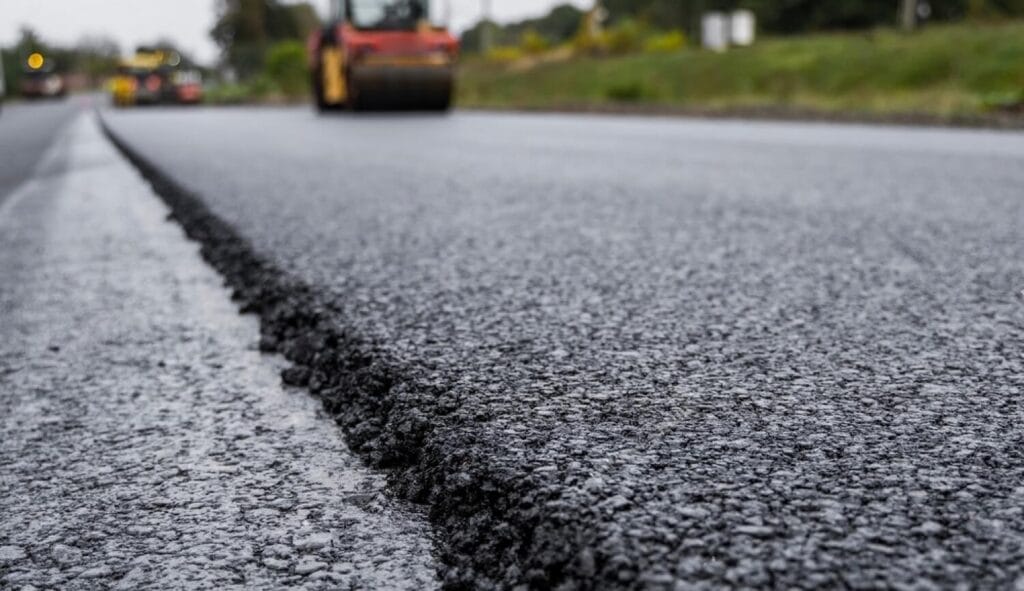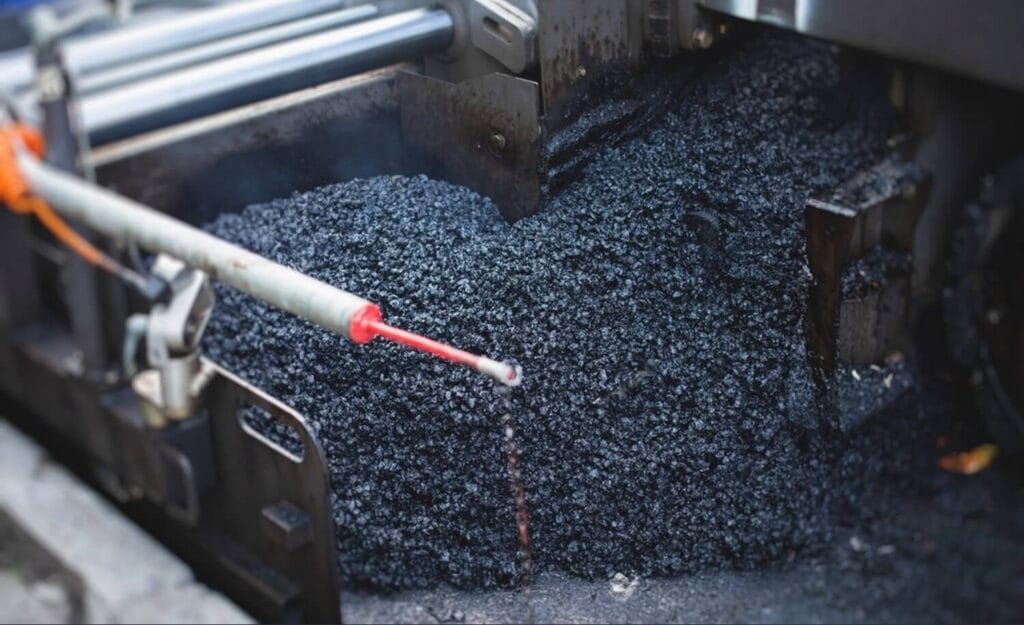Introducing asphalt construction for beginners! This article explores asphalt construction, including its definition, importance, benefits, and various aspects of its process.
This guide will provide valuable insight into the concrete construction industry. Whether you’re just starting or want to know more, this guide will give you useful information about pavement making.
Definition and Importance of Asphalt Construction
Asphalt construction is the process of using asphalt, a sticky, black, and highly viscous liquid or semi-solid form of petroleum, to build roads, pavements, and other infrastructure.
It is essential for creating long-lasting and reliable surfaces that can withstand heavy traffic and a variety of weather conditions.
Benefits of Using Asphalt for Construction
Here are some reasons why Tarmac is the preferred choice for construction projects:
Durability: Asphalt is a durable material that is ideal for roads and pavements that experience heavy traffic. It is flexible and resistant to cracking, making it a long-lasting surface.
Smooth Ride: Smooth asphalt surfaces make driving more comfortable and safe. They reduce road noise and vibrations, improving the overall quality of transportation.
Cost-Effectiveness: Asphalt is typically less expensive than other materials. It is also easier to install and maintain, which makes it a cost-effective option.
Quick Installation: Tar can be quickly laid and compacted, which significantly reduces project timelines. This ensures minimal disruption to traffic and nearby communities during construction.
Recyclability: Asphalt is a recyclable material, which means it can be reused in future projects. This not only reduces waste and landfill usage but also promotes sustainable construction practices.
Basics of Asphalt Construction
What is Asphalt?
Asphalt is a mix of crushed stone, sand, and gravel held together by asphalt cement, a petroleum-based binding material. It’s used for roads, parking lots, runways, and more. Its strength, flexibility, and durability make it great for various projects.

Types of Asphalt Mixtures
There are different kinds of asphalt mixtures, each made for specific project needs:
- Hot Mix Asphalt (HMA): The most common type, made at high temperatures. It’s great for all sorts of projects, from highways to driveways.
- Warm Mix Asphalt (WMA): A greener option, produced at lower temperatures. It’s eco-friendly, needs less energy, and still works great.
- Cold Mix Asphalt (CMA): Made at regular temperatures, good for quick fixes. No heating is needed, making it flexible for cold weather or emergencies.
Asphalt Composition and Properties
Asphalt is a mix of aggregates and asphalt cement. It can also have extras like polymers or fibers for better properties. The amounts of aggregates, asphalt cement, and extras decide how the asphalt turns out. This affects things like strength, flexibility, stability, and how well it resists damage.
Importance of Proper Asphalt Mixture Design
Getting the right mix of asphalt is super important. It needs to match the project’s needs. Things like how much traffic there will be, the weather, and what it’ll be used for all play a role.
Engineers pick the best aggregates, asphalt binders, and extras to make sure the pavement lasts and works great.
Paving Process
Paving is the process that makes tough, long-lasting surfaces for roads, driveways, and more. It’s a series of steps: get the ground ready, put down a solid base, and then add the actual paving material. For practical assistance, use our Asphalt Calculator to estimate material requirements for your project.

Site Preparation
Before you start paving, you’ve got to prep the site well. Clear out debris, plants, and anything that could get in the way. You also need to dig and level the area right, so the tarmac has a solid foundation to sit on.
Base Course Installation
The base course is like a sturdy layer of granular stuff on the prepared ground. It holds up the asphalt, spreading out the weight from cars and giving extra strength.
Picking the right base material and compacting it well is super important to make sure the pavement stays strong and lasts a long time.
Asphalt Mixture Placement
After the base is ready, they pour hot asphalt mix on it. Trucks bring it, and special equipment spreads it out evenly. Then, big rollers press it down to make it smooth and dense, just how they want it.
Compaction and Roller Operations
Compacting is a super important step in paving construction. It makes sure the asphalt stays strong and lasts. They use different kinds of rollers, like ones with steel wheels or big tires, to press it down right. The roller folks follow certain patterns to spread the force evenly and get rid of any empty spaces in the pavement.
Quality Control in Asphalt Construction
Quality control is essential in asphalt work. It makes sure the final product is up to the standards and safe to use. This guide will cover everything about quality control in asphalt work, from testing materials to the last check before it’s done.

Importance of Quality Control
Making sure quality is top-notch during asphalt construction is crucial for pavement that lasts. Quality control oversees everything, right from choosing materials and planning the mix, to constructing and compacting. Following strict quality control rules helps catch and fix issues early.
Asphalt Testing Procedures
While building, they run various tests to ensure top-quality asphalt. They examine how the aggregates are distributed, the amount of asphalt in the mix, its response to temperature changes, and its ability to withstand moisture. They also grab samples from the new pavement to check its strength and density.
Adjustments and Corrections During Construction
During construction, experts in quality control carefully monitor the entire paving process. If they notice any variations or changes, they can make adjustments to elements such as the asphalt mix, compaction methods, or roller techniques. These proactive measures ensure the pavement remains robust and avert potential issues in the future.
Asphalt Curing and Initial Maintenance
Curing Importance and Methods
Curing is super important for new asphalt to get strong and tough. They do it right by using methods like putting on curing stuff or using special blankets. These methods control the moisture and temperature of the asphalt, stopping it from drying out too soon and cracking. This keeps the pavement in great shape.
Preventing Premature Traffic Loading
To make sure the new asphalt pavement stays strong, it’s really important to avoid heavy traffic too soon. If it gets lots of weight or too many vehicles before it’s fully set, it can wear out quickly and even get damaged. Using plans to manage traffic and temporary markings can lower the chance of this happening.
Sealcoating and Surface Treatment
Sealcoating and surface treatments are ways to take care of asphalt pavements and make them last longer. These coatings shield the pavement, stopping moisture from getting in and slowing down the effects of aging, oxidation, and damage. If you regularly put on seal coating and surface treatment, the pavement can stay in good shape for a lot longer.
Traffic Management and Temporary Markings
Right after paving, it’s super important to manage traffic carefully to keep the fresh surface safe. Using temporary markings and signs helps drivers know where to go and prevent accidental harm. When construction zones and speed limits are clear, it cuts down on risks, keeping drivers and workers safe.
Long-Term Maintenance Practices
Regular Inspection and Maintenance Schedule
Doing regular checks and sticking to a maintenance plan is key to keeping tarmac pavements strong and lasting.
Inspections catch problems like cracks, potholes, or drainage issues early. When they fix things quickly and keep up with maintenance, it stops more damage and makes the pavement last longer.
Crack Sealing and Filling
Cracks are a common problem in asphalt pavements. Fixing them right with sealing and filling stops water and debris from getting in and causing more trouble.
They use stuff like asphalt emulsions or hot rubberized asphalt to seal and fill the cracks up well.
Patching and Repairs
When certain parts of the pavement get messed up, like potholes or wear and tear, they need patching and repairs.
This means taking out the damaged bit, putting in new asphalt, and pressing it down right. Doing this quickly and well stops things from getting worse and keeps the road smooth to drive on.

Resurfacing and Overlay Options
When the pavement is seriously worn out or has structural issues, resurfacing and overlays are good choices.
This means adding a fresh layer of asphalt, either right on top or after removing the old layer. It’s a smart way to make the pavement last longer and work better, without having to rebuild the whole thing.
Addressing Drainage Issues
Having proper drainage is essential to keep asphalt pavements in great condition. If the drainage isn’t good, it can make the pavement wear out faster and increase maintenance expenses.
To tackle drainage issues, it’s important to act quickly by ensuring there are correct slopes, effective drainage systems, and consistent maintenance. This approach helps the pavement last longer and perform at its best.

Environmental Considerations
Sustainable Asphalt Construction Practices
The asphalt industry is striving to be eco-friendly. They’re using old asphalt in new mixes, using less energy to make asphalt, and promoting recycling and reusing materials.
When construction projects adopt these green practices, it cuts down on waste, preserves resources, and adds to a more environmentally conscious future.
Recycling and Reuse of Asphalt Materials
Recycling and reusing asphalt materials are key parts of sustainable construction. They can use old asphalt (RAP) in new mixes, which cuts down on the need for new materials and reduces waste.
Also, methods like cold recycling and full-depth reclamation bring life back to existing asphalt surfaces, making the most out of what’s already there.
Environmental Impact Mitigation
Pavement Making projects are taking steps to reduce their environmental impact. They manage stormwater to prevent pollution, control erosion, and sediment, and minimize noise and air pollution during construction.
This focus on the environment helps road surfacing blend harmoniously with the natural surroundings.
Safety Precautions and Regulations
Importance of Safety in Blacktop Building
Safety is a top priority in asphalt construction, ensuring the well-being of workers and the public. Thorough safety procedures, proper equipment, and training are crucial to prevent accidents, injuries.
Following safety guidelines helps construction sites reduce risks and establish a secure work environment.
Personal Protective Equipment (PPE) for Workers
Personal Protective Equipment (PPE) is crucial for keeping workers safe in asphalt construction. This includes stuff like hard hats, bright clothes, gloves, safety glasses, and masks.
Wearing PPE the right way shields workers from dangers like asphalt fumes, stuff flying around, and risks from traffic.
Compliance with Occupational Safety and Health Administration (OSHA) Guidelines
It’s important to follow the rules set by the Occupational Safety and Health Administration (OSHA) in Blacktop Building. These rules cover lots of safety stuff, like explaining dangers, using masks, preventing falls, and much more. Sticking to OSHA rules keeps workers safe and lowers the chances of accidents and injuries.
Future Trends in Asphalt Construction
Smart Asphalt Technologies
With technology moving forward, the asphalt construction field is also progressing. Smart asphalt tech uses sensors, data systems, and new materials to watch over how the pavement’s doing, boost how well it works, and plan out maintenance better.
These smart tools help manage the pavement in a smart, money-saving way, leading to better roads that last longer.
Stay ahead of technological advancements with insights from sources like Engineering News-Record (ENR) in the evolving landscape of asphalt construction.
Renewable Energy Integration
Using renewable energy is becoming more popular in tarmac construction. They’re putting solar panels right into the pavement, so they can catch sunlight and turn it into energy. This isn’t just a green way to get power – it also helps cut down on carbon emissions from transportation.
Green Asphalt Production
Green asphalt production is all about making asphalt in an eco-friendly way. They use energy-efficient methods, eco-friendly materials, and tech to cut down on emissions.
By going green in production, the industry can shrink its carbon footprint and help create a cleaner, greener future.
Advancements in Asphalt Technology
Polymer-Modified Asphalt Mixtures
Polymer-modified asphalt mixes add special polymers to the tarmac binder, boosting how well it works. These mixes resist cracks better, hold up against heavy traffic, and stay strong for longer.
When they use polymer-modified asphalt, construction projects get pavements that last a long time and perform really well.
Porous Asphalt
Porous asphalt is a cool new pavement idea that lets water soak through and go into the ground below. It helps handle stormwater, lowers flood risk, and helps recharge groundwater. Besides being good for the environment, porous asphalt also makes driving smoother and quieter.
Warm Mix Asphalt Innovations
Warm Mix Asphalt (WMA) innovations are all about cutting down on energy use and emissions when making asphalt.
They let asphalt be produced and pressed down at cooler temperatures than the usual hot-mix kind. By using less energy, these innovations help with eco-friendly construction while still giving us top-notch pavements.
Challenges in Asphalt Construction
Extreme Weather Considerations
Crazy weather like scorching heat or freezing cold can make asphalt road construction tricky. When it’s super hot, asphalt gets hard to work with and presses down.
And when it’s really cold, it can mess with how well the asphalt works and how it’s pressed. To deal with these challenges and make sure pavements last, they adjust how they build and pick the right materials.
Traffic Management Strategies
During Road Surfacing, managing traffic well is super important to keep everyone safe – drivers and workers. They use signs, and ways to talk to each other to make sure traffic keeps moving and disruptions are small.
When planning traffic stuff, they think about all kinds of road users and make sure things go smoothly during construction.
Environmental Impact Reduction
Even though asphalt construction has improved its impact on the environment, we need to do more. Going for even greener practices, like using more recycled stuff helps cut down on how much asphalt affects the environment.
It’s important to make sure that the good things about asphalt construction don’t harm the environment.
Case Studies in Successful Asphalt Projects
Highway Rehabilitation
Highway rehab projects are great examples of how asphalt road construction can upgrade existing roads. They might redo the surface, make the road wider, or strengthen it to handle more cars.
The key to a successful highway rehab is using smart construction methods, being really careful about quality, and planning how to take care of the road for the long haul.
Urban Pavement Design
Designing pavement in busy cities is tricky because of all the traffic and lots of buildings and stuff around. Making urban pavement work well needs creative ideas, like using porous Bitumen or special things on the surface to make less noise.
These projects try to make city movement better, make the pavement last, and look good, while also thinking about walkers, bikers, and drivers.
Sustainable Parking Lot Construction
Building parking lots is a chance to be eco-friendly and give folks a good, strong place to park. Sustainable parking lot projects use things like permeable pavement,
smart ways to handle rainwater and lights that save energy.
These projects help save water, make places colder in the city, and make urban growth more eco-friendly overall.
Wrapping Up: Why Asphalt Construction Matters
To sum it up, This guide covers everything about asphalt construction, from start to finish. It’s a great resource for beginners and experts alike. Asphalt is a smart choice for roads because it’s affordable, quick to install, and easy to recycle.
This guide goes deep into asphalt, covering its composition, paving methods, and much more. The goal is to create better roads for everyone.
FAQ
-
How to prepare the ground before asphalt paving?
Clear debris, grade the surface, and compact the soil properly.
-
How long does it take for asphalt to cure?
It usually takes about 1 to 3 days for asphalt to cure.
-
How often should I seal coat my asphalt pavement?
Sealcoating should be done every 2 to 5 years for optimal protection.
-
How long does asphalt last?
With good care, asphalt can last for 20 to 25 years or even more.
-
Can we use asphalt when it’s cold outside?
Yes, but we need to be careful and use special tricks to make sure it stays strong.
-
Do we have to put a shiny coat on asphalt?
It’s like putting sunscreen on your skin – it protects the asphalt from harm.
-
What makes asphalt crack?
Cracks can come from the sun, rain, or even too much traffic.
-
Can old asphalt be new again?
Yes, we can use old asphalt to make new roads, just like recycling.
-
How does asphalt help our cities?
Asphalt makes roads and places for us to play and drive, making our cities awesome!
-
Can we walk or drive on new asphalt right away?
After a short nap (24 to 48 hours), it’s ready for you to enjoy!
